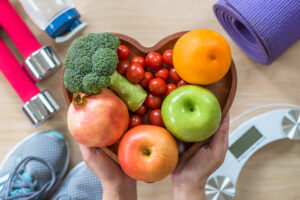
Simon Hill


In the fast-paced and demanding world we live in, finding moments of stillness and calm can be challenging. In an attempt to find a little peace...
If you want to get your gut in order, Dr Will Bulsiewicz is the expert to help you sort out fact from fiction. This is the gut-health cheat sheet...
A baked fruit crumble with crunchy granola topping and warm custard – this wholefood, plant-based creation is the ultimate guilt-free...
What’s better than a homemade treat? One that someone else has made especially for you! Delight your loved ones with these festive beauties...
This cinnamon-scented apple loaf uses almond meal and a flax egg to create a beautiful moist sponge, which contrasts perfectly with the sliced...
A true alchemy occurs when watermelon is baked and then cured in a flavoursome broth – it is a freaky and delicious raw-tuna copycat. I usually...
This recipe combines noodles, shiitake mushrooms and greens in a creamy spiced broth, creating a mouthwatering fusion of Japanese and Malaysian...
Fact: you don’t need eggs or dairy to make mouthwatering quiche. This beautiful recipe by Amanda Logan uses silken tofu, chickpea flour, and...
Spraying sheets and pillows with calming scents can be a wonderful aid to slumber
The next time you go for a walk, discover the wonder of the everyday world around you
A skincare routine can be a way to nourish yourself inside and out
When the clouds converge, practise gratitude for the smallest of glimmers, and learn to dance in the rain.
It’s easy to gain and hard to lose, and can have significant impacts on our health.
Weight-loss hype is all around us. It often comes to us in the form of product marketing, influencer recommendations, or compelling before and after shots – but is it helpful? In a world that pins the value of weight loss to our appearance, it’s more useful to step away from the focus on looks and instead understand the health repercussions associated with excess body weight.
Unfortunately, the modern lifestyle and environment doesn’t exactly set us up for success; weight is incredibly easy to gain and difficult to lose. Most of us have access to food whenever we like and sedentary habits that can lead to excess body fat. But statistics on disease and mortality show indisputable advantages to maintaining a healthy body weight. So just how much is excess body fat (aka adiposity) hurting our health? The answer is: significantly.
Adults with obesity are 12 times more likely to develop type 2 diabetes than those with a healthy body mass, and are approximately two times more likely to develop heart disease and depression. Adiposity can also trim years from our life, as demonstrated by a recent study of 3.6 million adults in the UK. This study found that non-smoking 40-year-olds with obesity had an average life expectancy four years shorter than non-smoking 40-year-olds with a healthy body weight. The bottom line is that excess body weight not only predisposes us to chronic diseases that affect our quality of life but is also a recipe for a shorter life.
While it is possible to be overweight and metabolically healthy, research increasingly shows that this is very often a transient state. Long-term studies reveal that many of these people eventually develop metabolic disease later in life and are at greater risk of having a cardiovascular event.
It’s well established that maintaining a healthy body weight is important, but not necessarily easy. Fortunately, it can be simpler than all that weight-loss hype makes out. Research suggests that rather than creating an extravagant game plan, we should instead develop our strategy based on a few fundamental pillars. Regardless of the latest science being touted, these will help you achieve and maintain a healthy body weight. Let’s explore them.
The first and most important fundamental is to focus on your diet quality. A common misconception around weight loss is that ‘carbs make you fat’. But the research is clear on this: when it comes to high-carb versus low-carb diets, neither outperforms the other. In study after study, we see the same weight loss with both approaches when participants are eating a high-quality (wholefoods-based) diet.
Interestingly, individual subjects within these studies varied in their results; some folks did better on lower-carbohydrate diets, while others experienced improved results on higher-carbohydrate diets. Pairing this knowledge with what we know about what foods are healthiest, we can confidently say that the best way to eat for weight loss, and overall health, can be either a low-carb or a high-carb plant-based diet. This information is incredibly beneficial for someone trying to lose weight, as it opens the options so people can find what works best for them. More options mean more chances for success!
What matters most is that regardless of which macronutrients you favour, your calories should be coming from whole or minimally processed plant foods.
What matters most is that regardless of which macronutrients you favour, your calories should be coming from whole or minimally processed plant foods. Ideally, look for a combination of foods that leave you feeling satiated (more on this shortly). If you choose to eat a higher-fat diet, seek out healthy sources of unsaturated fats such as nuts, seeds, avocado, tofu, and olive oil. If opting for a higher-carbohydrate diet, make sure you favour wholegrains, starchy vegetables, and legumes. Regardless of the macros you favour, your overarching pattern of eating should be low in saturated fat and ultra-processed foods while rich in fibre.
A fundamental rule for those with a goal of weight loss is that you need to consume less energy (which we refer to as calories) than your body expends. This is called a calorie deficit. While we can achieve a calorie deficit by using more energy through exercise and movement, the most effective strategy is to focus on the energy we ingest through our diet. For some, reducing or eliminating ultra-processed foods and focusing on high-fibre, protein-rich foods will be enough to promote a healthy body weight. For others, achieving a calorie deficit will require a little more attention.
There are three main tools that I like to discuss with people who are looking to lose weight. The idea is to use one that makes falling into a calorie deficit the easiest and most comfortable for you. The less effort you feel you are putting in, the more sustainable your dietary changes will be.
The first tool is to make sure you understand the number of calories per bite that a given food provides. This is referred to as calorie density. Foods that are calorie dense are easier to overconsume, whereas foods with fewer calories per bite are easier to fill up on without overconsuming calories. For example, a high-calorie-density food is olive oil, while examples of low-calorie-density foods are broccoli or mushrooms. Another useful tool is time-restricted eating. Shortening your eating window to 9–10 hours a day (for example 9am–7pm) can help promote a calorie deficit and significant weight loss. Whether this works for you will depend on your lifestyle, relationship with food, and current baseline eating window. The third tool is tracking calories. Some people swear by this, while others may find it restrictive or overwhelming. It isn’t for everyone, but can certainly be a helpful for understanding the amount of energy different foods provide.
You may find that using a combination of these tools works best for you. For example, eating within a 10-hour window and focusing on filling your plate with low-calorie-dense foods. You can use these tools to help you achieve a healthy body weight by aiming for a calorie deficit as well as maintain one by balancing energy in versus energy out.

The importance of resistance exercise and staying strong should not be underestimated when trying to maintain good health. There is a current craze around longevity supplements, but resistance training is one of the greatest longevity ‘hacks’ we have.
One study that followed a group of 70-year-old individuals for five years showed reduced grip strength was associated with a 23 percent greater chance of death. Grip strength is often used in studies because it’s a good indication of how strong someone is overall; however, I’m certainly not suggesting we just train our forearm muscles. At a minimum, I recommend doing three 45-minute resistance training sessions a week with at least two of these focused on the lower body. Ideally, for overall wellbeing, this should be accompanied by at least 150 minutes of moderate to vigorous aerobic exercise per week (for example, jogging, cycling, swimming, and so on).
While exercise may not be as effective as reducing calories when it comes to weight loss, it becomes increasingly important to help maintain weight loss once we have shed a few kilos to hit our health goals. Among people who lose significant amounts of weight, those who increase their exercise levels the most tend to be more successful at keeping that weight off in the long term.
The fourth fundamental of maintaining a healthy body weight is to focus on sleep. In our increasingly busy, technology-filled lives, this falls to the wayside for many people. How much sleep we get, and how well we sleep, affects our body weight. There is mounting evidence from clinical intervention studies that shows sleep deprivation promotes increased calorie consumption and greater amounts of visceral fat. Visceral fat is the fat around our organs and is particularly bad for metabolic health.
Research indicates that seven to eight hours of good-quality sleep per night is optimal for a healthy body weight and longevity. Commit to a sleep routine that involves a consistent bedtime in a cool, dark room and avoid late night snacking and blue light before bed. Early natural light exposure in the morning can also be helpful for regulating sleep patterns.
***
The beauty of a plant-based diet is that it is a dietary pattern of abundance. There are literally hundreds of different fruits, vegetables, wholegrains, legumes, nuts, seeds, herbs, and spices. And with so many wholefood, low-calorie-density choices, you can feel satiated and nourished instead of hungry or lethargic on the path to achieving your health goals. Rather than reducing weight loss to a matter of appearance alone, these fundamentals will help you feel your best and improve your long-term health outcomes. Your body will thank you for it.
In the fast-paced and demanding world we live in, finding moments of stillness and calm can be challenging. In an attempt to find a little peace...
If you want to get your gut in order, Dr Will Bulsiewicz is the expert to help you sort out fact from fiction. This is the gut-health cheat sheet...
Spraying sheets and pillows with calming scents can be a wonderful aid to slumber
The next time you go for a walk, discover the wonder of the everyday world around you
A skincare routine can be a way to nourish yourself inside and out
When the clouds converge, practise gratitude for the smallest of glimmers, and learn to dance in the rain.
Fresh, colourful, and satisfying, these smokey tacos with a kick of spice are the perfect way to enjoy tempeh during mango season.